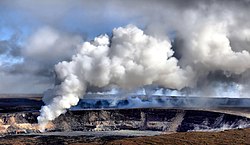Hawaiʻi Volcanoes National Park
Hawaiʻi Volcanoes National Park is a national park in the U.S. state and island of Hawaii. It is a UNESCO World Heritage Site.[2] The park was created in 1916. It includes The Mauna Loa, which is the Earth's biggest volcano, and Kilauea, the Earth's most active volcano.
| Hawaiʻi Volcanoes National Park | |
|---|---|
IUCN Category II (National Park) | |
 | |
| Location in the Hawaiian Islands | |
| Location | Hawaii County, Hawaii, US |
| Nearest city | Hilo |
| Area | 323,431 acres (130,888 ha) |
| Visitors | 2,016,702 (in 2017)[1] |
| Website | Hawaiʻi Volcanoes National Park |
| Criteria | Natural: viii |
| Reference | 409 |
| Inscription | 1987 (11th Session) |
The park shows the results of millions of years of volcanism, and evolution. These processes produce bare land from the sea, and with complex and unique ecosystems, a distinct Ancient Hawaiian culture. Kīlauea, one of the world's most active volcanoes, and Mauna Loa is the biggest, it offers scientists with insights on the birth of the Hawaiian Islands, and can give visitors views of the dramatic volcanic landscapes.
In recognition of its outstanding natural values, Hawaiʻi Volcanoes National Park has been designated as an International Biosphere Reserve in 1980 and a World Heritage Site in 1987.[3]
Recent events
On March 19, 2008, there was a small explosion in Halemaʻumaʻu crater, the first explosive event since 1924 and the first eruption in the Kīlauea caldera since September 1982.
Debris from the explosion was scattered over an area of 74 acres (300,000 m2). A small amount of ash was also reported at a nearby community. The explosion covered part of Crater Rim Drive and damaged Halemaʻumaʻu overlook. The explosion did not release any lava, which suggests to scientists that it was driven by hydrothermal or gas sources.[4]
This explosion event followed the opening of a major sulfur dioxide gas vent, greatly increasing levels emitted from the Halemaʻumaʻu crater.[5]
In 2008, Hawai'i Volcanoes National Park and Jeju Volcanic Island and Lava Tubes became sister parks.[6]
Gallery
Hawaiʻi Volcanoes National Park Media
Aerial view of Halemaʻumaʻu, September 2009
The Volcano Art Center was the Volcano House Hotel from 1877 to 1921.
D. Howard Hitchcock's 1929 painting of Pele
Sulfur dioxide emissions from the Halemaʻumaʻu vent, April 2008
Halemaʻumaʻu crater eruption in 2023
Night view of Halemaʻumaʻu from Jaggar Museum in 2015
Related pages
References
- ↑ "Five Year Annual Recreation Visits Report". Public Use Statistic Office, National Park Service. Retrieved 2018-02-26.
- ↑ UNESCO, "Hawaii Volcanoes National Park"; retrieved 2012-4-19.
- ↑ "Hawai'i's Only World Heritage Site". Hawai'i Volcanoes National Park web site. National Park Service. Retrieved 2009-12-02.
- ↑ Explosive eruption in Halemaʻumaʻu Crater, Kilauea Volcano.
- ↑ "Closed Areas". Hawai'i Volcanoes National Park web site. National Park Service. Retrieved 2009-12-02.
- ↑ Jeju Volcanic Island and Lava Tubes Sister Park Arrangement. National Park Service. June 2, 2017. https://www.nps.gov/havo/learn/management/sisterpark-jeju.htm. Retrieved August 17, 2020.
Other websites
![]() Media related to Hawaii Volcanoes National Park at Wikimedia Commons
Media related to Hawaii Volcanoes National Park at Wikimedia Commons
![]()









